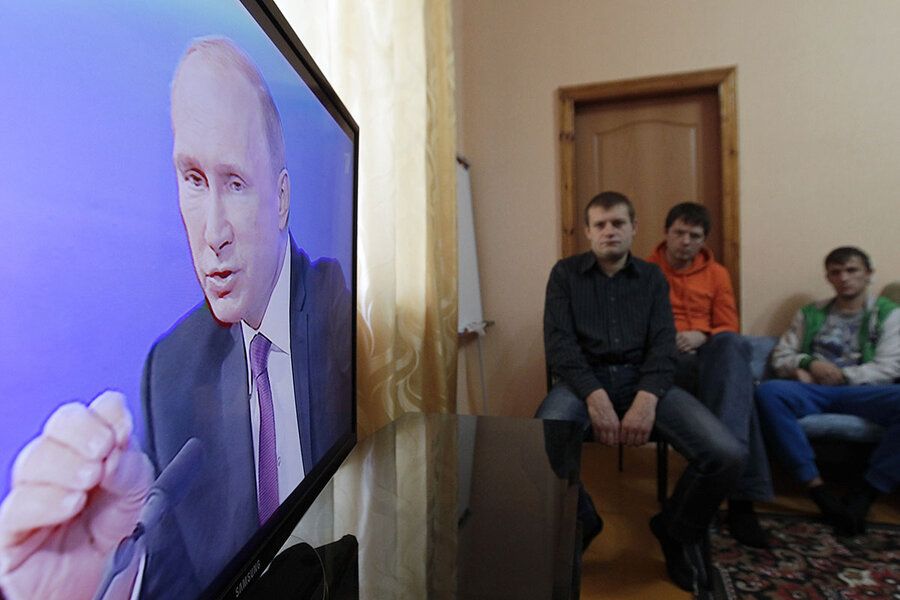Russian answer to opioid epidemic: 'Cold turkey'
Loading...
| Moscow
Yulia Morozova knows heroin addiction inside and out.
Today she is a clinical psychologist, helping people with addictions through the final stages of their recovery treatment at the sprawling Center for Practical and Research Narcology in southeast Moscow. But a decade or so ago she was a patient there herself, suffering “cold turkey” Russian-style.
The three-week withdrawal process was “not easy,” Dr. Morozova says now. But “everything that’s going to be interesting in your life happens after that. In my case, this was the only way. I have been clean for nine years now.”
Russia has an opioid addiction crisis about as grave as America’s. But the two countries’ approaches to the problem could hardly be more different. Where most US and European clinics offer patients methadone as replacement therapy, Russian doctors disdain such “soft” treatment.
They acknowledge that their methods of curing addiction have a lower success rate than the 50 percent achieved in the United States. Some put it as low as 10 percent. But they do not consider people who rely on methadone to be free from their addiction.
In Russia, says Yevgeny Bryun, who runs the 1,400 bed center where Morozova works, “We call a person's addiction in remission if they are completely drug-free. Not otherwise.”
So addiction treatment, like many other topics these days, has become a field for East-West sniping.
Who are you calling 'liberal?'
Russian doctors claim that the American crisis is the result of “liberal” attitudes that enable the over-prescription of powerful opioid pain killers, and lax medical approaches that treat heroin addiction with replacement therapy drugs like methadone.
Western doctors argue the Russian “cold turkey” approach to ending addiction is a brutal kill-or-cure solution that ignores the scientific evidence that replacement drugs can wean people off their addiction while allowing them to get on with their lives.
“Our philosophy is simple. We organize treatment and rehabilitation in a completely drug-free environment,” says Dr. Bryun. “In Russia it is illegal to use any drugs in treating drug addicts.”
Treatment in Bryun’s center – often ordered by the courts – starts with a mandatory 21-day withdrawal period when the patient undergoing “cold turkey” is kept under close supervision but given nothing more than aspirin to help weather the experience.
Russians who suffer through this experience call it the “vegetative state,” says Morozova, when you know nothing and you are not yourself.
That is followed by nearly three years of regular visits to the center as an outpatient, and then a final month in its rehabilitation wing, where the rules are so strict that even the strong-brewed Russian tea known as chifir is prohibited.
Around 720,000 of Russia’s 1.5 million citizens with a heroin addiction are currently undergoing such programs, says Bryun.
An Afghan heritage
Heroin was unknown in the Soviet Union until its troops invaded Afghanistan in 1979. Today as much as 20 percent of Afghanistan’s annual opium production makes its way through central Asia to Russia, flooding its cities with cheap heroin.
That history makes the origins and causes of Russia’s heroin habit very different from the US experience, where four out of five new users start out by misusing prescription pain killers.
“In Russia that’s impossible. You can’t obtain opioids in drugstores because there is very strict control,” says Dmitry Movchan, deputy director of the Marshak Clinic, a private addiction-treatment center in Moscow.
Too strict a control, perhaps. The extreme difficulty of obtaining strong painkillers condemns many patients to excruciating pain, often in the final stage of life, and some have even committed suicide.
“It’s true, we’ve erred on the side of making access to palliative medicines too difficult,” acknowledges Bryun. “We are developing policies … to find the right balance.”
But “allowing easy prescription access to opioids as tranquilizers or pain killers is reckless policy,” Dr. Movchan argues. “Over there [in the US] they ‘play democracy’ with drug addicts. But these are not people to be treated with half-measures. Either you cure them, and they stay clean, or they will have this addiction for their entire life,” he says.
That is a far cry from modern thinking in the West, where experts argue that Russians' fear of the “cold turkey” approach deters a lot of people with an addiction from seeking treatment in the first place, and that anyway it works only 10 percent of the time.
On top of that, one pillar of the Russian approach to drug addiction is a ban on Western-style programs that provide clean needles to patients in order to block the spread of HIV/AIDS. HIV infection rates have risen by about 10 percent annually in recent years, according to the Russian Federal AIDS Center, the third-fastest pace in the world. Half of new victims are infected by shared needles.
Tough love and 12 steps
Bryun says he debates frequently with Western colleagues at international conferences. He argues that the replacement therapies favored in the United States are often just the cheapest and easiest way to treat people who can’t afford to pay for expensive rehabilitation.
Those who can, he says, often opt for a “cold turkey” approach in private clinics which is not very different from the Russian way, though American doctors are readier to provide palliative drugs to suffering patients.
“In Russia we have an integrated system, and it is all paid for by the state. In our center you find all the facilities for detox, psychiatric and support services, and rehabilitation all together under one roof,” he boasts. “We view treatment as a single continuous process, and we follow each patient through the entire three year program.”
Morozova is one of the system’s success stories; she credits its “tough love” with curing her of her heroin addiction. But once her three-year program ended, she turned to a linchpin of Western addiction control that has caught on widely in Russia – “Narcotics Anonymous.”
“The 12 steps saved my life,” she says.






